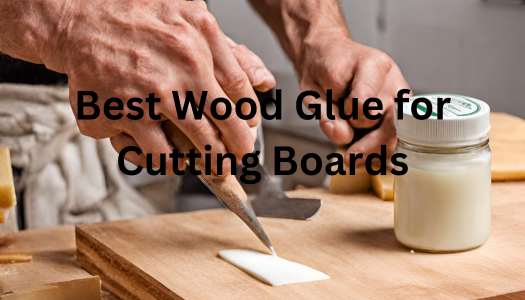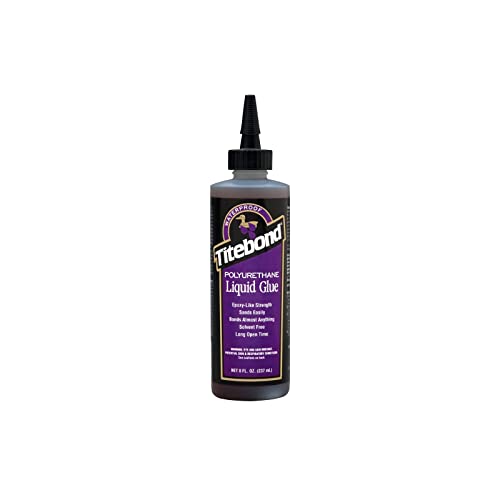Are you ready to discover the key to crafting the sturdiest, most enduring cutting boards? Brace yourself for an eye-opening journey through the world of wood glue.
The Titebond 5004 II Premium outshone the others after testing nine different products. My hands-on experience and expertise in the field led me to this remarkable find.
But the journey doesn’t stop there. We’ll delve deeper into its various other wood glues for woodworking scenarios.
Whether you want the best durability, value, or a specific purpose, we’ve got you covered.
Keep reading to unearth the adhesive that will elevate your woodworking projects to a new level.
Our Top Picks
Best Wood Glue for Cutting Boards
- Best Overall Glue for Cutting Boards – Titebond 5004 II Premium
- Best Bang for the Buck – Gorilla Wood Glue
- Most Durable Glue – Elmer’s E7050 Carpenter’s Wood Glue
- Best Cutting Board Glue for DIY Projects – Titebond 5063 Original
- Best for Professionals – Titebond III Ultimate Wood Glue
- Best for Composite Cutting Boards – Weldbond Multi-Purpose Adhesive
- Best Non-toxic Glue – Elmer’s E7310 Carpenter’s Wood Glue Max
- Best Glue for Butcher Block Countertop – Elmer’s E7502 4-Ounce Advanced
- Best Polyurethane Glue for Cutting Boards – Franklin Polyurethane Glue
Best Wood Glue for Cutting Boards (Updated Reviews)
To come up with the best glue for cutting boards, we considered the adhesive strength, ease of use, toxicity, assembly time, food safety, price-to-quality ratio, and water & heat resistance.
We also researched real customer cutting board wood glue reviews to ensure our recommended products are well-loved.
1. Best Overall Glue for Cutting Boards – Titebond 5004 II Premium
- First one-part wood glue to pass ANSI Type II water-resistance
- Unaffected by finishes, Easy cleanup with water
- Ideal for radio frequency (R-F) and hot press gluing systems
Titebond 5004 II Premium Wood Glue effortlessly claims the top spot when selecting the best wood glue for cutting boards. It’s not just good; it’s exceptional.
This wood glue from Titebond is a weatherproof powerhouse. It excels in hot and cold conditions, making it the ideal choice for items that must endure the test of time.
The bond it creates is so strong that it withstands heat and solvents, ensuring your cutting boards remain intact for years.
Titebond II Premium is incredibly versatile. It’s sandable, paintable, and non-toxic. This means that your cutting boards remain safe for food contact. You also have the flexibility to customize your creations without any concerns.
I’ve put Titebond II Premium to the test, and it exceeded my expectations. The adhesive strength is unparalleled and a breeze to work with. Even in challenging woodworking conditions, this glue has consistently delivered.
It outperformed competitors in both bond strength and resistance to environmental factors. Titebond II Premium outshines the rest.
While it may come with a slightly higher price tag than other wood glues, it’s worth every penny. With Titebond II Premium, you’re investing in unmatched durability, versatility, and safety for your cutting boards. It’s the epitome of value for your money.
What We Liked Most
- Exceptional weatherproof performance.
- Versatile and non-toxic.
- Outstanding bond strength.
- Easy to work with.
- Customizable and paintable.
What Could Be Improved
- Comes at a slightly higher cost.
- Slightly heavier due to its solid build.
2. Best Bang for the Buck – Gorilla Wood Glue
- Complete Projects Fast: Requires only 20-30 minutes of clamp time, fully cured in 24 hours. Quickly creates an incredibly strong bond for wood projects.
- Use Indoors or Outdoors: Passes ANSI/HPVA Type II water resistance. Can be used for all sorts of woodworking projects and repairs as an interior or exterior glue.
- Versatile: Ideal for use on hardwoods, softwoods, and natural wood composites. Is a great wood super glue for a wide variety of wood types and materials.
Gorilla Wood Glue is the ultimate budget-friendly choice, ranked second-best wood glue for cutting boards.
Gorilla Wood Glue delivers a quick and robust bond, requiring 20-30 minutes of clamp time and fully curing in 24 hours. This means you can complete your projects faster without compromising on the strength of the bond.
It is suitable for both interior and exterior woodworking projects. Whether you’re crafting cutting boards for the kitchen or outdoor picnics, this glue can handle it all.
This wood glue is not picky. It adheres perfectly to hardwoods, softwoods, and natural wood composites. It’s your go-to adhesive for various wood types and materials, ensuring project flexibility.
Gorilla Wood Glue dries to a natural color, creating a seamless bond line without foaming.
Plus, it’s paintable and sandable, allowing you to match different wood colors and meet various project requirements.
This water-based PVA glue is easy to work with and clean up. If you need to adjust, you can wipe off the glue while it’s wet and shave or sand it when hardened. Cleanup is a breeze with warm soap and water for your hands.
Gorilla Wood Glue is more budget-friendly than Titebond 5004 II Premium but doesn’t compromise quality. It offers quick bonding, indoor and outdoor use, and versatility across wood types. The primary difference lies in the drying time and the natural color finish.
What We Liked Most
- Non-toxic
- ANSI/HPVA Type II water-resistant
- Suitable for indoor and outdoor projects.
- Natural color finish, paintable, and sandable.
- Quick curing time.
What Could Be Improved
- Slightly longer clamp time compared to the first product.
- It may not have the same weather resistance as the first product.
3. Most Durable Glue – Elmer’s E7050 Carpenter’s Wood Glue
- Great for carpentry and home repairs
- Clean up soap and water when glue is wet scrape & sand when glue is dry
- 128 ounce (1 gallon) Carpenter's Wood Glue
On durability, Elmer’s E7050 Carpenter’s Wood Glue is the most rugged and reliable option.
Elmer’s E7050 is engineered for robust bonding that can endure time. It sets fast and bonds strong, ensuring your cutting boards remain intact even under heavy daily use.
Not only is this wood glue incredibly durable, but it’s also highly versatile. It’s sandable and paintable, allowing you to achieve a polished, customized finish on your cutting boards.
Plus, it’s non-toxic, with no harmful fumes, making it a safe choice for any woodworking project.
Subject to various conditions, Elmer’s E7050 consistently demonstrated impressive resilience.
Elmer’s E7050 Carpenter’s Wood Glue excelled in scenarios involving the crafting of heavy-duty cutting boards as well as delicate woodwork. It establishes itself as a go-to choice for unparalleled durability.
Elmer’s E7050 sets itself apart by focusing on durability as its primary feature.
It shares similarities with the Titebond 5004 II Premium and Gorilla Wood Glue. Its core strength is its ability to withstand the toughest wear and tear.
What We Liked Most
- Exceptional durability, perfect for heavy-duty projects.
- Versatile with sandable and paintable features.
- Non-toxic and safe to work with.
- Fast setting time for quick results.
- Strong, long-lasting bonds that outlast other glues.
What Could Be Improved
- Slightly longer clamp time compared to some alternatives.
- Strong odor due to fast setting; adequate ventilation is recommended.
4. Best Cutting Board Glue for DIY – Titebond 5063 Original
- This item is a Franklin International 5063 Titebond Original Wood Glue, 8-Ounce
- Purpose of use for Hardware, wood-glues
- This product is manufactured in United States
Now, we have come to another Titebond product on our list. Many years after it first came on the scene, Titebond 5063 Original Wood Glue is still as reliable as ever.
Unlike the newer iterations, this wood glue was made for interior use. This means it lacks the same water-resistance power as the Premium and Ultimate. As such, this version is better suited for building cutting boards than repairing them.
Indeed, the most outstanding feature of the Original wood glue is that it is heat, solvent, and mildew resistant, which makes it perfect for making a butcher block. The application process is also pretty seamless.
You get an assembly time of 4-6 minutes, so you need to work quickly or close the bottle more often. You must clamp it for 30 minutes to an hour before it dries.
Once fully cured, it is a food-safe glue, although it is not FDA-approved for indirect food contact.
You can use this wood glue on softwoods, hardwoods, and other porous materials. You can sand it and apply any cutting board finish you choose when done.
What We Liked Most
- It sets quickly
- It is mildew-resistant
- Easy clean up with water
- Non-toxic
What Could Be Improved
- It has limited water-resistance
- It is not FDA approved for indirect food contact
5. Best for Professionals – Titebond III Ultimate Wood Glue
- Superior waterproof wood glue is ideal for exterior and interior woodworking! One hour clamp time! Cleans up with water.
Next, we have Titebond III Ultimate Wood Glue took the plunge to help protect cutting boards even better from damage.
The first major distinction of Titebond III is that this formula passes ANSI/HPVA Type I water-resistance specification, making it waterproof like the previous wood glue on our list.
The next major difference is that you can apply this at temperatures above 47°F, as opposed to 55°F with Titebond Premium. You also get a longer open assembly time of 8-10 minutes.
While this longer time is great for beginners who work a little slower, it is also great for pros working on several projects simultaneously. After the glue sets, you can easily wipe off any excesses with a damp rag, making this the easiest wood glue to clean.
When it cures, you can sand it down and apply any cutting board finish you desire, not stain. The only thing to be mindful of is that this glue reacts with metal.
So, if you had planned on using a metal handle for the cutting board, ensure it doesn’t come in contact with the wet glue.
What We Liked Most
- ANSI/HPVA Type I water-resistant
- Easy to clean and sand
- Longer open assembly time
- Works with any cutting board finish
What Could Be Improved
- It corrodes metal
6. Best Glue for Composite Cutting Boards – Weldbond Multi-Purpose Adhesive Glue
- ✅ BONDS MOST EVERYTHING: No need to carry multiple types of glue bottles. This glue has unbelievable strength, is water resistant, weatherproof, dries crystal clear, is permanent and flexible.
- ✅ GREAT FOR CARPENTRY: Bonds stronger than wood! Easy to sand and paintable. No run, no drip. Easily cleans up with water. Fast setting in only 20 minutes, no clamping required.
- ✅ PERFECT FOR MOSAIC PROJECTS: Clear glue, bonds most tiles and hard surfaces such as glass, ceramics, porcelain, pottery, stone, marble, granite, clay, cork, slate, and composite like Corian.
The problem with most wood adhesive glues is that you can only use them for attaching two pieces of wood. That leaves very little room for creativity.
You need very versatile glue to make a cutting board with wood and other materials like polyethylene, glass, or metal.
Weldbond Multi-purpose adhesive glue is an absolute beast when making composite cutting boards. It glues nearly any material to wood.
Moreover, you can mix it with sawdust to fill cracks in your cutting board. As you’d expect, you can sand over this glue when it cures (it needs 24 hours).
However, you may not expect that you can apply stain on your cutting board even before the glue fully dries.
Something else we like about this is that it is non-toxic, releases low volatile organic compounds (VOCs), and is made without animal byproducts. When you’re done applying it, just snap the cap back on.
You don’t have to worry about it drying out or being unable to reopen the cap. You can also buy a convenient size for your project. These features come at a slightly steeper price, but it is worth every dime.
What We Liked Most
- It is non-toxic
- It can glue different materials
- It can be stained
- It comes in convenient sizes
What Could Be Improved
- Slightly more expensive than competitors
7. Best Non-toxic Glue – Elmer’s E7310 Carpenter’s Wood Glue Max
- Extra-strength wood adhesive
- Non-toxic, no harmful fumes and easy to clean up with water
- Sandable and Paintable
Apparently, Elmer’s wasn’t happy with being second or third best, so they came up with this non-toxic monster wood glue! The Elmer’s Carpenter’s Wood Glue Max is a product unlike any other. But first, let’s start with the basics.
Just like the previous version, this is water-based, non-toxic wood glue. You can safely apply it to kids and pets without any major concerns. Even if you eat (please don’t) a tiny portion of this, you’d still be fine.
You can clean this up with water. It sets in half an hour and needs a day to cure. Now, unto the best parts! This wood glue is certified ANSI Type I water-resistant (which means it is waterproof) and sustainable!
As if this wasn’t enough to smash the opposition, this is heat, mold, and mildew resistant. These features make it as close to perfect for cutting boards as possible.
The only limit to this glue is that you can’t use it to glue other materials, but it doesn’t matter if you only make or fix cutting boards. You can paint over this, too, but we wouldn’t recommend that for cutting boards.
What We Liked Most
- It is waterproof
- It is heat resistant
- It is mold and mildew resistant
- It is stainable
What Could Be Improved
- Still need to wait 24 hours to cure
8. Best Glue for Butcher Block Countertop – Elmer’s E7502 4-Ounce Advanced
- Professional-strength, all-purpose, and multi-surface glue
- Bonds metal, glass, ceramics, wood, stone, concrete, and more
- 100% weatherproof, non-toxic, no foam, and less mess
Our last product is another cheat code – it isn’t exactly wood glue, but works like it. Elmer’s Advanced ProBond is a multi-surface adhesive for stacking wood, ceramics, glass, metal, concrete, and more.
This highly versatile adhesive is 100% weatherproof and non-toxic, making it perfect for composite cutting boards that will be put through their paces, like in a restaurant kitchen.
Advanced ProBond was designed to compete against the versatility of polyurethane wood glues and excel at it.
One advantage of this butcher block glue is that it does not foam nor make a mess during application. A little drop of this goes a long way on any material. You also don’t need to wet the surface before it sticks.
Once applied, clamp this butcher block glue down for 20 to 30 minutes and let it cure for at least 24 hours. It will dry translucent, but you can clean up any excesses with water.
You can also paint over this or apply cutting board finishes.
Although this butcher block glue is non-toxic, it should only be used to join the parts of the cutting board that won’t touch food, i.e., it is unsuitable for fixing cracks.
What We Liked Most
- It works on different surfaces
- 100% weatherproof
- Short clamp-time
- Non-toxic
What Could Be Improved
- Not suitable for fixing broken cutting boards
- Premium pricing
9. Best Polyurethane Glue for Cutting Boards – Franklin Polyurethane Glue
- 100% waterproof
- Versatile performance
- No-run, no-drip formula
Polyurethane glues are renowned for being versatile, but the Franklin International Titebond Polyurethane Glue takes it to another level.
Unlike the typical wood glue, you can use this on a wide range of cutting boards, no matter the material. You can join wood to wood or wood to plastic, polyurethane, metal, or whatever your heart desires.
Something else we love about this cutting board wood glue is its elasticity. There is a bit of leeway when it joins pieces together, but the bond is nearly indestructible. Once cured – allow 1 to 3 days – this is 100% waterproof, making it one of the most durable options for cutting boards and other projects.
Unlike typical polyurethane, this is solvent-free and is food-safe after curing. You also get a long open time of 20 minutes, and your project will begin to harden in as little as 3 minutes. However, you must clamp this down for at least 45 minutes, or there’ll be a noticeable gap between boards.
When you use it, there is a mild odor, but it’s all gone once cured.
What We Liked Most
- Great for composite cutting boards
- It has a long open time
- You can sand and stain it easily
- It is 100% waterproof
What Could Be Improved
- It has a bit of an odor
- It is toxic during the application
Types of Cutting Board Glue
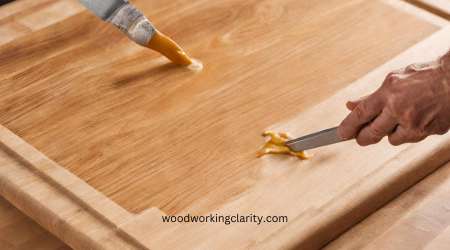
Cutting boards are one of the most delicate of the different woodworking projects. Because they come in contact with food, not every type of glue is suitable for cutting boards.
The last thing you need when making Sunday roast is to ingest some poison. So, here are the five types of wood glue and what makes each one suitable or unsuitable for cutting boards.
Polyvinyl Acetate Glue (PVA)
When you see a product labeled as “wood glue,” chances are the manufacturers are referring to polyvinyl acetate.
So, what is PVA glue?
PVA is a synthetic resin that forms a very strong bond very quickly. It is the most common glue used for woodworking projects.
Besides forming a strong bond, it is often water-resistant, heat-resistant, non-toxic, and easy to clean with water. PVA can either be yellow, like Titebond Ultimate Wood Glue and Elmer’s, or white, like Weldbond and Gorilla Wood Glue.
As you would have noticed from our list, PVA is the best wood adhesive for cutting boards. Being water and heat-resistant glue, it won’t melt when you place hot foods on it or when you wash it. Some PVA glues are also mildew-resistant.
A few brands have also gotten FDA approval for indirect food contact, which is rare for wood glue.
Cyanoacrylate Wood Glue (CA)
Next is cyanoacrylate wood glue, or as laymen call it, super glue. Yes, we all know and love superglue because it is strong, fast, and versatile. Once stuck, it is a nightmare to undo.
Users also like it because of its thin viscosity (sometimes medium viscosity), which makes it very quick to apply. Unfortunately, CA glue can be removed, so it isn’t recommended for cutting boards.
Like how you can get super glue off your skin with nail polish remover, so can it come off when in contact with heat.
Once it melts and comes in contact with food, you can get Cyanoacrylates Poisoning. So, while it is great for household repairs, keep products like Krazy Glue and Super CA.
Epoxy
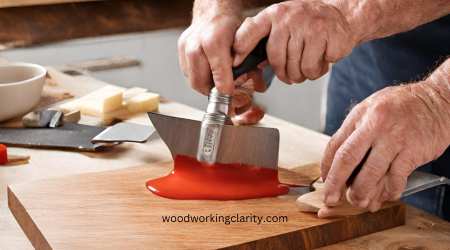
Epoxy glue is a two-part glue that is a mixture of a resin and epoxy polymer, called a hardener. It forms a strong bond, durable and waterproof bond on wood and a wide range of materials.
Epoxy glue is also handy at filling cracks in wood and, of course, beloved river tables. However, as great as epoxy resins are, they are not common options for woodworking because they require two parts and are slightly tricky to apply.
In its liquid state, epoxy glue is not food-safe. However, once it fully cures, it has the same properties as plastic, so it is technically food-safe.
So, why didn’t we include any on our list? One problem is that epoxy needs to be cured at least 30 days before it is food-safe.
The second and most important is that manufacturers are unwilling to say it is food-safe, probably because they are concerned about beginners applying it incorrectly and getting plastic casting resin poisoning.
Epoxies are also difficult to sand and are quite expensive compared to PVA glue. That said, if you’re a professional with experience with epoxy, this could be a great option for cutting boards.
Polyurethane
Like epoxy, polyurethane glues are strong adhesives that perform just as well as their topcoat counterpart. Poly glue is a synthetic plastic resin that forms a strong yet slightly flexible bond.
When fully cured, polyurethane also forms a plastic-type finish. What many woodworkers love about polyurethane is that it is highly versatile and can be used on different materials.
You can also apply a stain over cured poly pretty easily. The problem with polyurethane glue for cutting boards is that it releases harmful fumes before it cures.
As such, many people don’t want it in contact with food even when it fully dries. That is why it is best to make boards instead of fixing broken ones.
Hide Glue
The last type of glue was the first wood glue ever made. Hide or leather glue is made from animal collagen and sold in liquid or crystal form.
Because of its natural-looking color, hide glue is often used for antique restorations. Hide glue is also food-safe and is sometimes used in cereal boxes.
However, hide glue melts when exposed to water. As such, it wouldn’t do much good when used on a cutting board. Otherwise, this would have been the perfect choice, no contest.
How to Choose the Best Wood Glues for Cutting Boards
Now that we’ve covered the different types of glues and you’ve seen our list, how will you find the right one? Here are the factors to consider in relative order of importance.
Water and heat-resistance
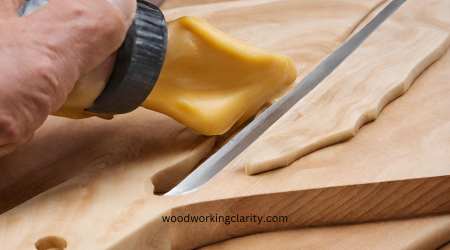
Cutting boards go through a lot of abuse from knives, cleavers, falling food, pots, pans, and so much more. As such, it is easy to want to prioritize strength first. However, the most abuse they come under is what we rarely notice.
No matter how strong the wood adhesive is, it is useless on a cutting board if it isn’t water-resistant. Therefore, the strongest glue for wood must be excellent in this regard.
This is where Titebond III Ultimate Wood Glue and Elmer’s Carpenter’s Glue Max excel, as they are waterproof and heat resistant. In contrast, Titebond Original is great but not as water-resistant.
Adhesive strength
Once you have a product that won’t melt under underwater pressure, you can now consider its bond strength. A thin glue line should be enough to hold your cutting board together. This is an area where all of our list’s products excel.
However, if you want to make a composite cutting board, some are better. Weldbond, Elmer’s Advance ProBond, and Titebond Polyurethane are great for mixed materials.
Gorilla wood glue and the max versions of Titebond and Elmer’s glue are your best options for strictly wooden cutting boards.
Ease of use/assembly time
This feature is more subjective. Some people like a long assembly time, while others are happy with a few minutes. A long assembly time allows you to make a mess and clean it up before the glue sets.
This will prevent the need to sand the dry wood glue afterward. If it has a short assembly time, it should be easy to sand. The Titebond III glue gives a generous time allowance, making it great for beginners and professionals.
If you want to reduce the amount of glue you use on your cutting board, consider buying a glue bottle dispenser to help you get the right amount of glue out without squeezing too hard and making a mess.
Toxicity
This has been covered in the previous section, but it is worth mentioning again. To prevent glue poisoning, you need to ensure that you use non-toxic or non-toxic glue when it fully cures.
All of the PVA glues on our list are non-toxic. The Poly glue is toxic during application but harmless when fully cured. If you apply the wood glue indoors or near children and pets, stick with PVA.
Finishing preference
What do you want the finished cutting board to look like? Will you be applying a stain or a cutting board finish? Or will you sand it and be ready for use?
The type of finish you can use will depend on the wood glue you choose. Elmer’s Max glue is the most welcoming to sanding, staining, and painting. You can also apply stain on the poly and Weldbond.
Price
Finally, it’s good also to consider your budget. However, don’t prioritize it over other factors like adhesive strength or waterproofness. When the products are indistinguishable, there is no need to go for the more expensive option.
If you’re only working with wood, you don’t need to spend extra on Elmer’s Advanced when you can get Elmer’s Wood Glue Max.
Optimal Storage for Prolonged Glue Shelf Life
Proper storage is key to ensuring the best wood glue for cutting boards lasts longer. Seal the container tightly after use to prevent air exposure.
Store it in a cool, dry place away from direct sunlight or extreme temperatures. The ideal temperature range is 55-75°F (13-24°C).
Avoid freezing or overheating, as it can affect the glue’s quality. Additionally, keeping the glue upright prevents leaks and maintains its consistency.
Check for any signs of separation or clumping before using. A well-preserved wood glue will maintain its bonding strength, making it a reliable choice for cutting board projects.
The Ultimate Wood Glue for Cutting Board
It is easy to understate how important cutting boards are until they break. Even though some are inexpensive to replace, fixing them back together is still much cheaper. Ensure you use wood glue with all the right qualities.
And so, it is no surprise that the best wood glue for cutting boards is Titebond 5004 II Premium. Besides being very strong, it is a weatherproof powerhouse that can withstand hot and cold conditions.
As you pick your adhesive glue for the next project, you should invest in the best cutting board wood.

